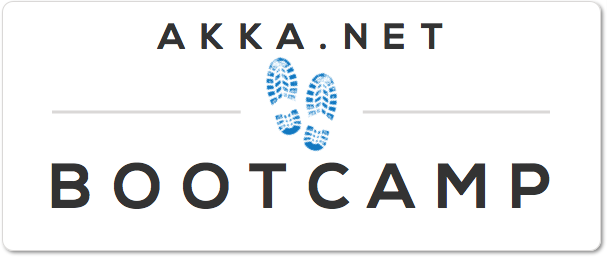Introducing... Akka.NET Bootcamp!
5 minutes to read- Introducing Akka.net Bootcamp
- What Is Bootcamp?
- Why Should I Do Bootcamp?
- What Will I Learn In Akka.NET Bootcamp?
- Is It Really Free?
- How Can I Get Help Along the Way?
- How Do I Get Started?
Over the last several months, interest in Akka.NET has increased dramatically. And yet, many people find the actor model intimidating and can’t seem to really get up and running. Developers want to learn how to use Akka.NET, but where do they go? There haven’t been very many good answers to that question. Until now.
We decided to fix that.
And so…
Introducing Akka.net Bootcamp
I’m pleased to announce that we’ve launched Akka.NET Bootcamp to provide this exact learning resource to developers everywhere!

We put bootcamp together to help you learn the insanely powerful actor model in an accessible, fun way. The course starts from fundamentals and takes you all the way to knowing what you need to in order to create sophisticated, distributed apps in .NET.
What Is Bootcamp?
Bootcamp is a free, self-directed learning course. You can do it at whatever pace you wish. Bootcamp launched initially in C# only, but F# support is almost done. Hundreds of developers around the world are already members of Bootcamp.
Why Should I Do Bootcamp?
You know that you need to get ahead of the curve and learn about distributed computing, functional programming, and cloud computing. When we started learning about distributed computing, we were overwhelmed by the sheer amount of things we needed to know. Consistent hashing, consensus algorithms, PAXOS, Raft, replication strategies… the list goes on and on.
We know that with this much information to learn, it’s hard to digest it all. We’ll show you what you actually need to know. We’ve removed all the fluff and you’ll learn to understand the actor model from the ground up.
What Will I Learn In Akka.NET Bootcamp?
Great question.
In Akka.NET Bootcamp you will learn how to use Akka.NET actors to build reactive, concurrent applications.
You’ll learn how to build types of applications that may have seemed impossible or really, really hard prior to learning Akka.NET - and you will walk away from this bootcamp with the confidence to handle bigger and harder problems than before.
Unit 1
In Unit 1, we will learn the fundamentals of how the actor model and Akka.NET work.
*NIX systems have the tail command built-in to monitor changes to a file (such as tailing log files), whereas Windows does not. We will recreate tail for Windows, and use the process to learn the fundamentals.
In Unit 1 you will learn:
- How to create your own
ActorSystemand actors; - How to send messages actors and how to handle different types of messages;
- How to use
PropsandActorRefs to build loosely coupled systems. - How to use actor paths, addresses, and ActorSelection to send messages to actors.
- How to create child actors and actor hierarchies, and how to supervise children with
SupervisionStrategy. - How to use the Actor lifecycle to control actor startup, shutdown, and restart behavior.
Unit 2
In Unit 2, we’re going to get into some more of the intermediate Akka.NET features and build a reactive UI application.
In Unit 2 you will learn:
- How to use HOCON configuration to configure your actors via App.config and Web.config;
- How to configure your actor’s Dispatcher to run on the Windows Forms UI thread, so actors can make operations directly on UI elements without needing to change contexts;
- How to handle more sophisticated types of pattern matching using
ReceiveActor; - How to use the
Schedulerto send recurring messages to actors; - How to use the Publish-subscribe (pub-sub) pattern between actors;
- How and why to switch actor’s behavior at run-time; and
- How to
Stashmessages for deferred processing.
Unit 3
In Unit 3, we will learn to make our system more scalable and resilient.
In Unit 3 you will learn:
- How to perform work asynchronously inside your actors using PipeTo;
- How to use Ask to wait inline for actors to respond to your messages;
- How to use ReceiveTimeout to time out replies from other actors;
- How to use Group routers to divide work among your actors;
- How to use Pool routers to automatically create and manage pools of actors; and
- How to use HOCON to configure your routers.
Is It Really Free?
Yes, it’s really free. Akka.NET is an amazing open source software project and we are working hard to spread the word about it, and help as many developers as possible take advantage of it.
How Can I Get Help Along the Way?
The best option is to go to the ongoing Akka.NET Bootcamp chat room here. Many participants have been asking questions there, and the team of Akka.NET contributors is in there answering/helping out.
How Do I Get Started?
Sign up in the email form below, and we’ll email you a lesson per day.
(If the signup form doesn’t display correctly for you, click here to sign up instead.)
###
Hundreds of developers around the world are already members of Bootcamp. Get started today! Have any questions about what you’ll learn, or how Bootcamp is going? Leave a comment below and we’ll be glad to address it.
If you liked this post, you can share it with your followers or follow us on Twitter!
- Read more about:
- Akka.NET
- Case Studies
- Videos
Observe and Monitor Your Akka.NET Applications with Phobos
Did you know that Phobos can automatically instrument your Akka.NET applications with OpenTelemetry?
Click here to learn more.
